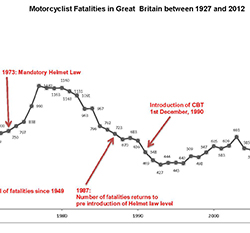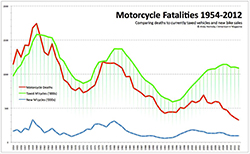 Usually our posts here on the website get replicated onto our Facebook page, however a post about a graph – “Motorcycle Fatalities in Great Britain between 1927 and 2012″* – on the Facebook page has sparked an interesting debate.
Usually our posts here on the website get replicated onto our Facebook page, however a post about a graph – “Motorcycle Fatalities in Great Britain between 1927 and 2012″* – on the Facebook page has sparked an interesting debate.
Our original comment accompanying the graph was:
“MAG UK (Motorcycle Action Group) has been highlighting freedom of choice and reiterating their opposition to the Helmet Law which was introduced in 1973.
A lot of people are either for and agin, but sometimes it helps to look at facts and figures….
That’s what we do at Right To Ride.
Most important is that following the introduction of the helmet law, fatalities skyrocketed.
Possibly more of interest is the introduction of CBT in 1990 and the consistent fall in fatalities.
Our mantra is, it’s not what you wear, but what you know!
So chaps and chapesses – ride safe, ride free and take care out there.”
 But we all know that it’s just not that simple and passions can push people into opposing camps, especially on this very emotive subject. MAG UK and its volunteer regions and groups recently held rideouts commemorating Fred Hill who died in prison on the 10th February 1984.
But we all know that it’s just not that simple and passions can push people into opposing camps, especially on this very emotive subject. MAG UK and its volunteer regions and groups recently held rideouts commemorating Fred Hill who died in prison on the 10th February 1984.
Fred was 74 when he died of a heart attack in custody during his 31st prison sentence, while fighting against a bureaucratic interference with his choice to ride a motorcycle without wearing a crash helmet.
The purpose of producing the chart by Right To Ride’s, Elaine Hardy, was to have a discussion about statistics and not simply about helmets and the law, although there is no escaping that particular discussion, given our own background from MAG UK and those posting up comments.
The comments were stimulating and ranged from querying the validity of the data to recognising that personal choice and responsibility are all relevant in discussions of this nature.
Those advocating personal protection and helmet useage gave their views while others commented on for example – common sense.
Others Thoughts
 Andy Hornsby from American-V magazine joined in the discussion looking at what could possibly effect the fatality rate at certain points in time, with his theory on 60mph mopeds FSIE etc in the seventies which may have contributed to the high fatality rate.
Andy Hornsby from American-V magazine joined in the discussion looking at what could possibly effect the fatality rate at certain points in time, with his theory on 60mph mopeds FSIE etc in the seventies which may have contributed to the high fatality rate.
Andy wrote, “What I have done is cross-referenced your figures to the contemporary ‘taxed motorcycles’ from veh0103 and ‘new motorcycles’ from veh0153, which makes interesting reading: the fatality rate closely mirrored the number of bikes on the road for a long time but has been diverging since 2003 with number of bikes on the road increasing and death rates consistently falling – particularly interesting as the vehicles on the road and new vehicles is diverging too.
I’ve seen a breakdown of motorcycle sales by capacity somewhere in the official stats: will add that when I have time to find it, to see whether the 60mph moped theory bears fruit.”
Our Own Comments
 “We can all give examples of motorcycle collisions and their outcomes and how really did the person end up in the situation they did. That makes the, it doesn’t really matter what people wear comment be put into context. Right up to the point of potentially having injuries it doesn’t really matter what a rider was wearing.”
“We can all give examples of motorcycle collisions and their outcomes and how really did the person end up in the situation they did. That makes the, it doesn’t really matter what people wear comment be put into context. Right up to the point of potentially having injuries it doesn’t really matter what a rider was wearing.”
“You got to step back before the collision and look and then forward to the small time space that a rider has to react. Then you got to look at the other vehicle driver/s if there was one – the road – the weathered etc there are so many variables.This is why we have forensic scientists and coroners looking in-depth at fatal collisions.”
“As for what you wear, then that loops around to personal choice again and legislation to make wearing of safety gear mandatory, if it’s ok for helmets why not for full protection for all riding gear or indeed Hi-Viz?”
And a last bit on helmets, “Wearing a helmet became mandatory in Italy in the 1990s and the interesting fact about that is that now most Italians (apart from Naples) wear a helmet – but NOT because it’s the law – and that’s because Italians generally don’t care about laws, but because they actually believe that it matters. So I guess we can ask the question – does wearing a helmet matter? It probably does.”
However back on track , one commenter said, “There are probably many other ‘factors’ to be taken into consideration but the information shown is very interesting and, as proven here, gives rise to much debate.“
Intelligent Debate
 With the discussion turning to motorcycle safety an intelligent debate about motorcycling opened up.
With the discussion turning to motorcycle safety an intelligent debate about motorcycling opened up.
“………do believe that education is the largest factor in the safety debate. Just simple things like looking far ahead and turning your head and looking where you want to go etc. make a huge difference”
“…….. Unquestionably: education is key.”
“……..I draw on my experience of helping youngsters (aged 6 upwards) into racing grasstrack. First thing is to teach them to start and more importantly STOP under control and with confidence. Next is to look as far ahead as possible which gives more time to react to hazards etc. Follow this with look where you want to go, turn your head and your bike will follow! The science behind all of that is obviously much deeper but simple instructions are much better.”
“……. Emergency braking is very important and difficult to simulate without causing danger to others. We used to use an empty pop bottle and practise squeezing on a scale of 1 to ten repeatedly because it trains your brain not to just ‘grab a handful’ Not a perfect method perhaps but it’s all I could think of.”
“……. training and more training and hazard awareness.”
Responsibility
 What is relevant in this discussion is that – at the time – i.e. in 1973, the government argued that mandatory helmet usage would reduce fatalities.
What is relevant in this discussion is that – at the time – i.e. in 1973, the government argued that mandatory helmet usage would reduce fatalities.
It didn’t.
Now, we can argue that in any event, at the time around 80% of motorcyclists wore helmets anyway.
That wasn’t the issue. It was simply that the Minister for Transport made a decision and used fatality rates as his excuse and enacted it through parliament.
So using the same logic of the government at the time, following the introduction of the legislation mandating helmet usage, fatalities increased. Logically, that could have been due other factors.
The fact of the matter remains that the introduction of helmet legislation – at the time – didn’t amount to a hill of beans in reducing fatalties.
The rates increased until 1977 and then plateaued until 1982, when they started to decline.
Just to reiterate, the purpose of the whole discussion was to look at the data provided by the DfT to highlight points in time over the last 85 years when legislation or events occurred and of course have an interesting debate.
From our perspective at Right To Ride, there is a fundamental element that was not included in the discussion, which is responsibility.
We could and would argue that there is absolutely nothing wrong with riding a motorcycle round to the shop helmetless, that there is nothing untowards riding a short distance in a T-shirt on a stinking hot day (as happens in Southern European countries).
What is required in both cases and indeed what is equally required riding long distances – is 1) common sense and 2) responsibility.
We are, or we should all be responsible for our own actions and answerable to our own sense of what is right.
Responsible Freedom
 In the litigious world we live in, we need to make a choice – do we want to see our children grow in a “safe” little world of boredom and inaction so that they “survive”? or do we need to teach them that being responsible for one’s own actions, while respecting the rights of others – may mean taking risks or it may also mean that wearing a helmet can be good common sense and is all considered, being responsible.
In the litigious world we live in, we need to make a choice – do we want to see our children grow in a “safe” little world of boredom and inaction so that they “survive”? or do we need to teach them that being responsible for one’s own actions, while respecting the rights of others – may mean taking risks or it may also mean that wearing a helmet can be good common sense and is all considered, being responsible.
It’s a choice we need to think about, but in the end, it should be just that – a choice.
It’s too late now to rescind the helmet law and it is unlikely that any person or organisation in Europe at least, would have the stomach to try.
But it does open up a wider debate about risk society and just to what degree we can accept legislation to determine how we behave in our day to day lives.
To conclude based on a focus group of experts – i.e. trainers, examiners, police etc. “The consensus was that the only reliable way to prevent motorcyclist injuries and deaths is to prevent the collision in the first place, which means the rider needs to get his/her eyes up and scanning ahead, taking evasive action when a potential collision is still several seconds from happening”.
In other words, prevention is always better than cure.
Links – Information
Right To Ride On Facebook – Click Here
The Motorcycle Helmet Law in the UK – Click Here
“Motorcycle Fatalities in Great Britain between 1927 and 2012” – pdf – 86kb – Click Here
*The data available is for GB (Great Britain) and does not include Northern Ireland
American-V Magazine – www.american-v.com




Speak Your Mind